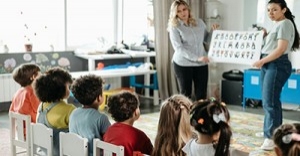Principles of Play
-
Universal Right to Play:
-
Every child has an inherent right to play. It's not just an activity but a vital component of their learning and development.
-
Play should be balanced to foster healthy minds, bodies, and overall well-being.
-
It builds communication skills and enhances language and cognitive development.
-
-
Connection to the World:
-
Play connects children to their cultural identities, others, and various ways of knowing, doing, and being.
-
It's a collective responsibility to understand, protect, and value the importance of play in every community.
-
-
Developing a Pedagogy of Play:
-
Educators should intentionally incorporate play into their professional practice, recognizing its benefits daily.
-
Link children’s play to their home environments and document it to make it visible to families.
-
Ensure sufficient resources and time are allocated for play within the learning program and curriculum.
-
-
Communication and Literacy:
-
Integrate literacy, vocabulary, and mathematical concepts into everyday activities and play provocations.
-
Foster diverse communication and language sharing in the learning community.
-
-
Support for Complex Ideas and Emotional Expression:
-
Support children's expression of complex ideas and difficult experiences through play. Identify when specialist support may be needed.
-
-
Cultural and Local Context Integration:
-
Incorporate different traditions and practices of play into the curriculum through authentic engagement with local contexts and cultures.
-
Encourage exploration of local natural or social phenomena, such as learning on Country or visiting local landmarks.
-
-
Advocacy for Safe and Inclusive Play:
-
Promote play that ensures safe participation and prioritizes children’s agency.
-
Advocate for play as a key component of educational programs, fostering environments where every child can participate and reach their potential.
-
These principles emphasize creating a nurturing and inclusive environment that respects the diverse backgrounds and needs of each child.
Integrating These Principles Into Your Practice
Applying the principles of play in your classroom can create a vibrant, engaging, and supportive environment for young learners. Here’s how you can put these principles into action:
1. Universal Right to Play
-
Ensure Playtime: Allocate specific times throughout the day dedicated to free play. This allows children to explore, imagine, and learn at their own pace.
-
Balance Activities: Incorporate a mix of physical, social, imaginative, and cognitive play activities to develop a well-rounded set of skills.
2. Connection to the World
-
Cultural Inclusion: Include play activities that reflect the diverse cultural backgrounds of your students. Celebrate different traditions and incorporate them into your play-based learning.
-
Community Involvement: Engage with the local community by inviting guest speakers or organizing field trips that connect children to their local environment.
3. Developing a Pedagogy of Play
-
Intentional Play: Plan and incorporate play into your daily lessons. Use play as a tool to teach specific concepts and skills.
-
Documentation: Document and share children's play experiences with families through photos, videos, and written observations.
4. Communication and Literacy
-
Language-Rich Environment: Create a literacy-rich environment with books, writing materials, and interactive storytelling sessions.
-
Math Through Play: Use play-based activities to teach mathematical concepts, such as counting games, puzzles, and building blocks.
5. Support for Complex Ideas and Emotional Expression
-
Emotional Expression: Provide materials and opportunities for children to express their feelings and ideas through art, role-play, and storytelling.
-
Specialist Support: Identify when children may need additional support and connect with specialists as needed.
6. Cultural and Local Context Integration
-
Authentic Experiences: Integrate local cultural practices and natural phenomena into your curriculum. For example, explore local wildlife, traditions, or community events.
-
Field Trips: Organize visits to local places of interest such as farms, factories, or cultural centers to enhance learning through real-world experiences.
7. Advocacy for Safe and Inclusive Play
-
Safe Play Environment: Ensure that your classroom is safe and inclusive. Adapt play activities to meet the needs of all children, including those with different abilities.
-
Inclusive Practices: Promote an environment where every child feels valued and included. Encourage group play and collaboration.
Additional Tips:
-
Reflect and Adapt: Regularly reflect on your play-based practices and adapt them to meet the changing needs of your students.
-
Professional Development: Engage in continuous learning about play-based education through workshops, courses, and professional networks.
By integrating these principles, you can create a dynamic and enriching learning environment that nurtures every child's potential.
Examples Of Successful Play Integration
1. Literacy Through Play
Example: In a preschool classroom, a "Book Nook" is created with a variety of books, comfortable seating, and props related to the stories. Children are encouraged to read, act out stories, and create their own narratives. This play area enhances language skills and fosters a love for reading.
2. Math and Science Exploration
Example: A classroom sets up a "Discovery Zone" with materials like measuring tools, magnifying glasses, and natural objects (rocks, leaves, insects). Children engage in hands-on experiments and activities, learning basic math and science concepts through exploration and play.
3. Dramatic Play
Example: A "Home Corner" is designed with kitchen sets, costumes, and role-play materials. Children engage in pretend play, which helps them develop social skills, empathy, and understanding of daily routines. This area also allows children to act out real-life situations and practice problem-solving.
4. Physical Play
Example: An outdoor playground is equipped with various physical play structures like slides, climbing frames, and sandpits. Children engage in physical activities that promote gross motor skills, coordination, and overall physical health. The playground also includes spaces for group games and activities that encourage teamwork.
5. Cultural Integration
Example: A classroom celebrates different cultural festivals and incorporates traditional games and activities into the play curriculum. For instance, during Diwali, children create rangoli designs using colored sand and participate in storytelling sessions about the festival. This helps children appreciate cultural diversity and fosters inclusion.
6. Emotional Expression
Example: A "Quiet Corner" is set up with soft furnishings, calming materials, and sensory toys. Children can retreat to this space when they need a break or want to manage their emotions. This area supports emotional regulation and provides a safe space for children to express their feelings.
7. Nature Play
Example: An outdoor "Nature Classroom" is created with garden beds, water play areas, and natural materials like logs and stones. Children engage in gardening, explore natural elements, and learn about the environment. This play area fosters a connection with nature and promotes ecological awareness.
8. Collaborative Play
Example: A "Building Zone" with blocks, construction sets, and loose parts encourages children to work together on building projects. This area promotes teamwork, problem-solving, and creativity as children collaborate on various constructions.
9. Inclusive Play
Example: A classroom includes adaptive play equipment and materials that cater to children with different abilities. Play areas are designed to be accessible to all children, ensuring that everyone can participate and enjoy the activities.
These examples demonstrate how play can be seamlessly integrated into the classroom environment to support various aspects of children's development.
Practical Steps To Implement These Examples
Implementing these examples in your learning environment can be practical and rewarding. Here are some detailed steps to help you get started:
Literacy Through Play
Step 1: Create a Book Nook
-
Materials Needed: Books, comfortable seating, props related to stories.
-
Action: Set up a cozy corner with a variety of books and seating options. Add props like puppets or costumes related to the stories to encourage children to act out scenes.
-
Implementation: Read stories aloud, encourage children to explore books independently, and create opportunities for them to retell stories using the props.
Math and Science Exploration
Step 2: Set Up a Discovery Zone
-
Materials Needed: Magnifying glasses, measuring tools, natural objects (e.g., rocks, leaves).
-
Action: Designate a space in the classroom where children can explore natural objects and conduct simple experiments.
-
Implementation: Provide prompts and questions to guide their exploration. For example, ask them to measure the length of leaves or observe the texture of rocks.
Dramatic Play
Step 3: Design a Home Corner
-
Materials Needed: Kitchen sets, costumes, role-play materials.
-
Action: Create a space that mimics a home environment with kitchen sets, costumes, and other role-play materials.
-
Implementation: Encourage children to engage in pretend play, taking on roles and acting out real-life scenarios. This helps develop social skills and empathy.
Physical Play
Step 4: Enhance the Outdoor Playground
-
Materials Needed: Play structures, sandpit, balls, climbing frames.
-
Action: Equip the outdoor playground with various physical play structures and materials.
-
Implementation: Organize group games and activities that promote gross motor skills, coordination, and teamwork.
Cultural Integration
Step 5: Celebrate Cultural Festivals
-
Materials Needed: Traditional games, cultural props, storytelling materials.
-
Action: Incorporate cultural festivals into your curriculum by celebrating different traditions and including related games and activities.
-
Implementation: Organize storytelling sessions about the festivals, create cultural crafts, and engage children in traditional games.
Emotional Expression
Step 6: Create a Quiet Corner
-
Materials Needed: Soft furnishings, calming materials, sensory toys.
-
Action: Set up a quiet space with soft furnishings and calming materials where children can retreat when they need a break.
-
Implementation: Encourage children to use this space to manage their emotions and provide them with sensory toys to help them relax.
Nature Play
Step 7: Establish a Nature Classroom
-
Materials Needed: Garden beds, natural materials (e.g., logs, stones), water play areas.
-
Action: Create an outdoor area where children can engage with nature through gardening and exploration.
-
Implementation: Organize activities like planting seeds, exploring natural elements, and learning about the environment.
Collaborative Play
Step 8: Set Up a Building Zone
-
Materials Needed: Blocks, construction sets, loose parts.
-
Action: Designate a space for collaborative building projects using blocks and construction sets.
-
Implementation: Encourage children to work together on building projects, fostering teamwork and problem-solving skills.
Inclusive Play
Step 9: Adapt Play Materials
-
Materials Needed: Adaptive play equipment, inclusive materials.
-
Action: Ensure that your play areas are accessible to all children by incorporating adaptive play equipment and materials.
-
Implementation: Adapt play activities to meet the needs of children with different abilities and create an inclusive environment where everyone can participate.
These steps should help you integrate play principles effectively into your environment, creating a dynamic and supportive learning environment for all children.
Linking Play Principles To The EYLF
Linking play principles to the EYLF is essential for creating a holistic and effective learning environment for young children. Here are the play principles and how they can be linked to the EYLF:
EYLF Principles and Play
-
Secure, Respectful, and Reciprocal Relationships:
-
Play Principle: Building strong, trusting relationships through play.
-
EYLF Link: Children feel safe, secure, and supported, which fosters their sense of identity and well-being.
-
-
Partnerships:
-
Play Principle: Collaborating with families and communities to support children's play.
-
EYLF Link: Children are connected with and contribute to their world, enhancing their social and emotional development.
-
-
High Expectations and Equity:
-
Play Principle: Providing inclusive play opportunities that cater to diverse needs and abilities.
-
EYLF Link: Children develop a strong sense of well-being and confidence as learners.
-
-
Respect for Diversity:
-
Play Principle: Incorporating cultural elements and diverse perspectives into play activities.
-
EYLF Link: Children respond to diversity with respect and develop a sense of belonging to groups and communities.
-
-
Ongoing Learning and Reflective Practice:
-
Play Principle: Continuously improving play-based learning practices through reflection and professional development.
-
EYLF Link: Educators enhance their teaching practices, supporting children to become confident and involved learners.
-
Examples of Linking Play to EYLF Outcomes
-
Outcome 1: Children Have a Strong Sense of Identity:
-
Activity: Role-playing and dramatic play to explore different identities and social roles.
-
Theoretical Link: Erik Erikson's theory of psychosocial development emphasizes the importance of identity formation through play.
-
-
Outcome 2: Children Are Connected with and Contribute to Their World:
-
Activity: Nature-based play and environmental exploration.
-
Theoretical Link: Jean-Jacques Rousseau's advocacy for children's connection to nature and their environment.
-
-
Outcome 3: Children Have a Strong Sense of Well-being:
-
Activity: Creative arts and free self-expression activities.
-
Theoretical Link: Friedrich Froebel's emphasis on creativity and motor expression in promoting well-being.
-
-
Outcome 4: Children Are Confident and Involved Learners:
-
Activity: Hands-on problem-solving and experiential learning activities.
-
Theoretical Link: John Dewey's promotion of experiential learning and problem-solving.
-
-
Outcome 5: Children Are Effective Communicators:
-
Activity: Language-rich play and social interactions.
-
Theoretical Link: Lev Vygotsky's emphasis on language and social interactions in cognitive development.
-
By integrating these play principles and activities into the EYLF, educators can create a rich and supportive learning environment that addresses the diverse needs and strengths of each child. This approach helps children develop a strong sense of identity, connect with their world, maintain well-being, become confident learners, and communicate effectively.
Further Reading
Spontaneous Play In Early Childhood
Benefits Of Sensory Play
Open Ended Play Materials
Kenneth Rubin - Theories Of Play
Stages Of Play
Unstructured Play Materials For Children
Educators' Role In Play
Sensory Play for Children And Its Importance
Children and Weapon Play In Early Childhood Services







 As an Educator in Australia, your pay rate falls under the Children’s Services Award 2010. This award states the minimum amount that an employer can
As an Educator in Australia, your pay rate falls under the Children’s Services Award 2010. This award states the minimum amount that an employer can When working as a qualified Early Childhood Teacher (with a university degree) within a service, your rate of pay will come from the Educational Services
When working as a qualified Early Childhood Teacher (with a university degree) within a service, your rate of pay will come from the Educational Services When working as a Diploma Qualified Educator your pay rate is from the Children's Services Award 2010. This Award states your minimum rate of pay
When working as a Diploma Qualified Educator your pay rate is from the Children's Services Award 2010. This Award states your minimum rate of pay When working as a Cert 3 Qualified Educator, your pay rate is from the Children's Services Award 2010. This Award states your minimum rate of
When working as a Cert 3 Qualified Educator, your pay rate is from the Children's Services Award 2010. This Award states your minimum rate of Educational Leaders play a crucial role in their early childhood service by ensuring that the educational program aligns with best practices and supports the holistic
Educational Leaders play a crucial role in their early childhood service by ensuring that the educational program aligns with best practices and supports the holistic In early childhood education and care, ratios are more than a technicality—they are a frontline safeguard. Every child deserves responsive supervision, emotional connection, and developmental
In early childhood education and care, ratios are more than a technicality—they are a frontline safeguard. Every child deserves responsive supervision, emotional connection, and developmental Here’s a comprehensive Mobile Phone and Smart Watch Policy tailored for early childhood education and care (ECEC) services in Australia, aligned with the latest 2025
Here’s a comprehensive Mobile Phone and Smart Watch Policy tailored for early childhood education and care (ECEC) services in Australia, aligned with the latest 2025 With the new national child safety reforms kicking in on 1 September 2025, early childhood services like yours have a real opportunity to lead the
With the new national child safety reforms kicking in on 1 September 2025, early childhood services like yours have a real opportunity to lead the The Sea of Fish Challenge is a national initiative that invites children, educators, families, and communities to create and display fish artworks as a symbol
The Sea of Fish Challenge is a national initiative that invites children, educators, families, and communities to create and display fish artworks as a symbol Across the early childhood education and care sector, educators are sounding the alarm: current staffing ratios are insufficient to deliver safe, meaningful, and developmentally appropriate
Across the early childhood education and care sector, educators are sounding the alarm: current staffing ratios are insufficient to deliver safe, meaningful, and developmentally appropriate


